-
Posts
1,211 -
Joined
-
Last visited
-
Days Won
8
Content Type
Profiles
Forums
Blogs
Gallery
Events
Store
Posts posted by Great Dane
-
-
Ulsterman and Owain,
I stand (a little bit ) corrected after researching a bit.
Since 1981 recipients of this medal are recorded and are asked to provide a short biography of themselves.
Unfortunately that is too late for Owain's medal.
/Michael
0 -
Hmm... that's new to me. Besides the Chapter of the Orders (who doesn't have any lists), I wouldn't know who would keep such lists...
But if the - more recent - information is listed on a website, I'm sure it can't hurt to ask the persons behind the site.
/Michael
0 -
I could be mistaken, of course, but I have no knowledge of - or ever heard of - such records.
/Michael
0 -
Allow me to correct that number:
The number of medals awarded (Frederik IX, silver without crown) was 1947.
During the reign of Frederik IX (1947-1972) two types of this medal were struck, with a slight variation in the small bow on the reverse. Yours seems to be the type that was struck 1965-71.
/Michael
0 -
Yes, that number includes all recipients. The number is known due to the records of struck medals in the Royal Mint.
However, no records exist of who was awarded. That information was simply not recorded.
After the fall of absolutism in 1849, the awarding of medals and orders was given to the parliament (all recipients still have to be formally approved), except for the Medal of Recompense.
That medal was awarded by the King to whomever he felt deserved it, and as a result of that - unfortunately - no records were kept.
/Michael
0 -
Hi Owain,
Congratulations on a great looking bar

Regarding the Danish medal, it is the Royal Medal of Recompense (Frederik IX version). This version could be awarded in gold (silvergilt) or silver, both with or without crown.
The awarded version would depend on the importance of the recipient or if it had been awarded previously.
For Frederik IX, silver without crown, a total of 1953 medals were awarded.
The medal was awarded by the King (government approval was not necessary), so there is no list of recipients (to my knowledge).
The Royal Medal of Recompense was very often awarded to court officials during state visits, like you mention.
/Michael
0 -
The (short) story behind the order:
Until 1918 the Order of Dannebrog was used as an award for Icelanders (for the periods Iceland was under Danish sovereignty). When Iceland became independent in 1918, King Christian X of Denmark (who was still the monarch of Denmark and Iceland) decided to institute a new order - the Order of the Falcon.
When one looks at the recipients, a lot of them were foreigners (mostly Danes), and the order was more and more used as a "demi-Dannebrog" - i.e. an award to people who did not deserve the more esteemed Order of Dannebrog. Many of the recipients did not have any connection with Iceland. The same approach were used in other countries, e.g. the Order of the Black Star of Benin in France etc.
In 1944 Iceland was declared a republic, and the Danish King was no longer King of Iceland. To reflect this, the order changed it appearance (suspension and reverse medallion).
/Michael
0 -
Thanks a lot for this information.
I have actually read the mentioned book "En Dansk Ingeniørs Erindringer" a couple of years ago and found it very entertaining.
No doubt the group belonged to one of the engineers working on the railway project in Persia, but are you sure Mr. Saxild is the best bet?
Since he was promoted further within the order of Dannebrog, he would have been obliged to return the Knight Cross - and of course after his death all the orders of Dannebrog (whatever the classes) would have to be returned.
On numerous occasions the latter principle was not followed (although the Chapter of the Royal Orders was/is very eager in this matter), but not returning a Knight Cross when receiving a higher class would have been simply unheard of...
But whatever the story behind this group is, I can assure you it's in caring and loving hands

/Michael
0 -
Maybe the Schleswig-Holstein war cross for the war against Denmark 1848-50?
Or would that be a too early decoration?
/Michael
0 -
I guess that's possible.
There's a fairly well-known swedish football club called "IFK Göteborg" whose colors are blue and white.
But that could of course be a coincidence...
We do have some Swedes in the forum who might be able to help more.
/Michael
0 -
It looks a lot like swedish (unofficial) medals for various athletics clubs - both the suspension type and the two coloured ribbon.
/Michael
0 -
Hi,
I can contribute with a complete set of medals from Denmark.
From left to right:
- Copenhagen Fire Brigade long service medal (inst. 1903)
- The County Towns' Fire Brigade long service medal (inst. 1906 - now obsolete)
- Long service medal for the Fire Brigades in the country (inst. 1928 - now obsolete)
- Frederiksberg Fire Brigade long service medal (inst. 1926)
- The Fire Brigade long service medal (inst. 1973)
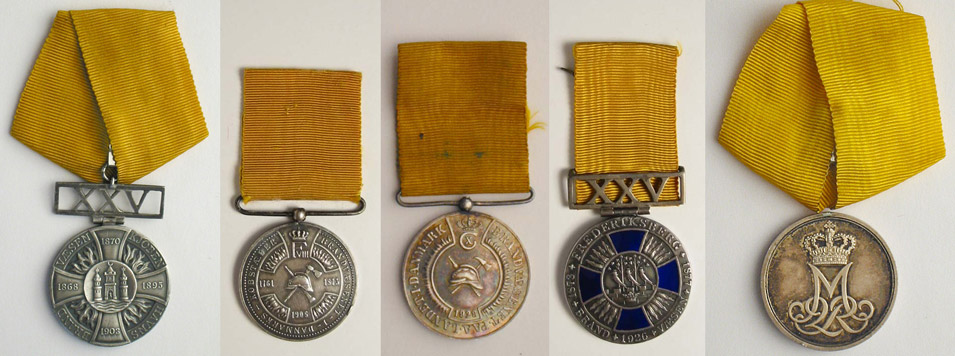
/Michael
0 -
Thanks, Gavin
His name was Andreas August Kinch.
He retired from the Navy due to age in 1903 (he was born in 1861). From 1903 to 1908 naval advisor in Chihli, China and recalled for duty in Naval Intelligence in 1914.
Finally retired as a captain in 1918.
Thanks for all the great info

/Michael
0 -
Thanks a lot for this thorough explanation. As I mentioned I tried to learn from reading auction catalog descriptions, but I just got more and more confused...
The miniature is too small to provide any additional info, I'm afraid. Around the center stone (in the light blue enamel) are just 12 golden 'dots'.
According to his file, he was a "Naval advisor to the viceroy of Chihli in China" 1903-08 (my translation from danish to english might not be accurate, but I hope you get the meaning).
At that time his rank was lieutenant (he became captain in 1917), but he might have been appointed temporary captain when he was stationed abroad (this seems to be normal procedure).
At least that would explain the 3. class, 3. grade award.
Was the 3. class, 3. grade worn on the breast?
And was the ribbon blue with yellow side stripes as on the miniature?
/Michael
0 -
Hi Gavin,
You seem to know what you're talking about

I have always found this area rather difficult, since even auction catalogues seem to name this decoration with random type, class and grade descriptions...
Are you able to identify this decoration below?
I only have his miniature decorations.
It was awarded approx. 1908 and in his papers it is called "3. class, 3. grade", but they (and even himself) might not have known exactly what he was awarded...
/Michael
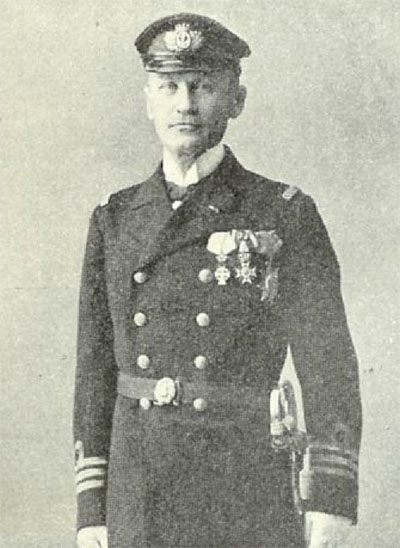
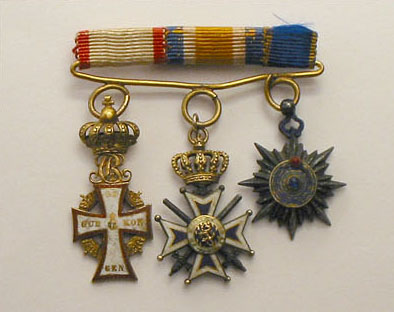 0
0 -
Here is another rare icelandic medal:
It is the "Commemorative Medal on the Restoration of the Republic 1944" ("Heiðursmerki til minningar um endurreisn lýðveldisins 1944").
Struck in USA in 10 K gold.
It was meant to be awarded to members of the Althing (52 members in 1944), a few other icelanders and to 8 special envoys from foreign states.
Two members of the Althing refused to receive it and 3 diplomates could not receive it due to the regulations of their countries.
So 75 medals were struck, but only 70 awarded.
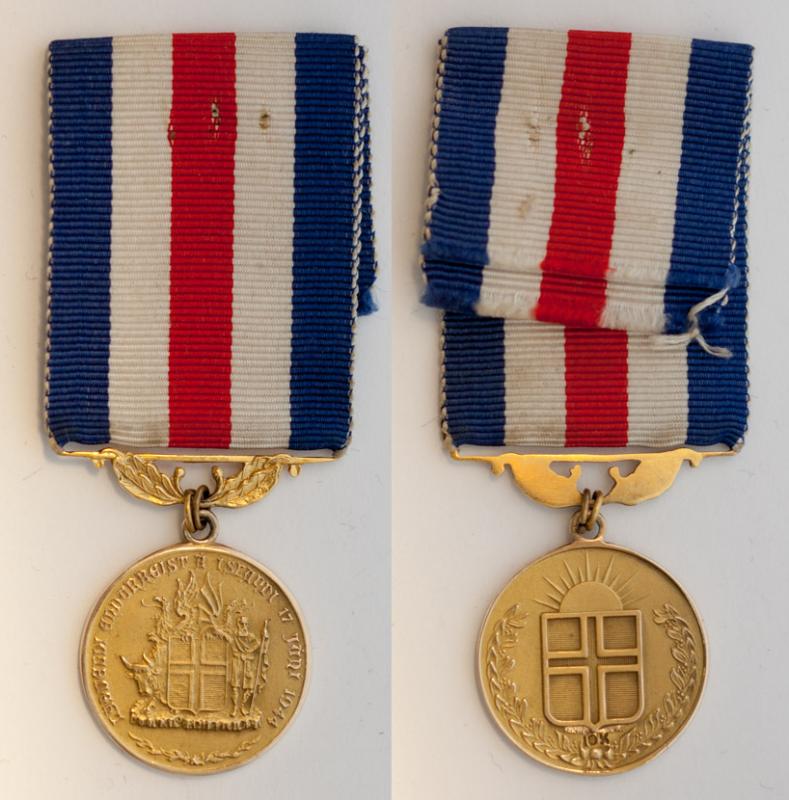
/Michael
0 -
No problem Megan,
The Althing medal is a commemorative medal awarded to the members of the icelandic Althing (42 members in 1930) and to the heads of parlaments of other countries who took part in the celebrations.
It was also awarded to members of the danish royal family (who took part) and a few persons chosen by the icelandic minister.
Here is another photo:
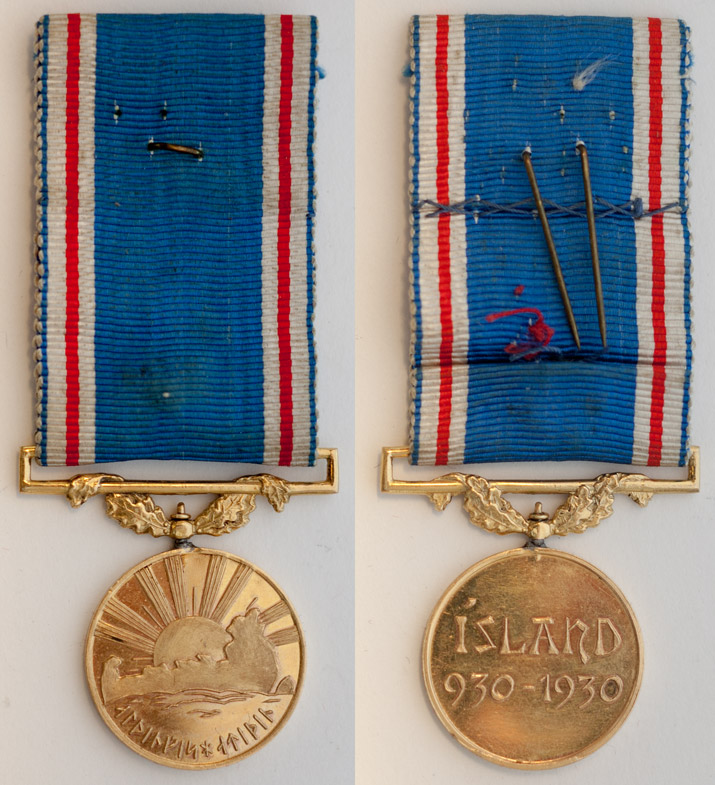
/Michael
0 -
The icelandic name is "Heiðursmerki Alþingishátíðarinnar 1930" (note the icelandic characters)
If you want better photos, let me know.
/Michael
0 -
Not entirely wrong... only 121 awarded.
/Michael
0 -
Hi North Denmark,
If you PM me, I have a possible recipient for that last bar.
/Michael
0 -
Whoa, that was fast

Thanks Glenn.
/Michael
0 -
Hi guys,
Apologies if this one is too easy, but imperial Germany is not normal hunting ground and I might even have difficulties telling Wilhelm II from Salvador Dali...

Do you know who this guy is?
I'm interested in his name because of his danish Order of Dannebrog at the end of his bar.
Thanks,
Michael
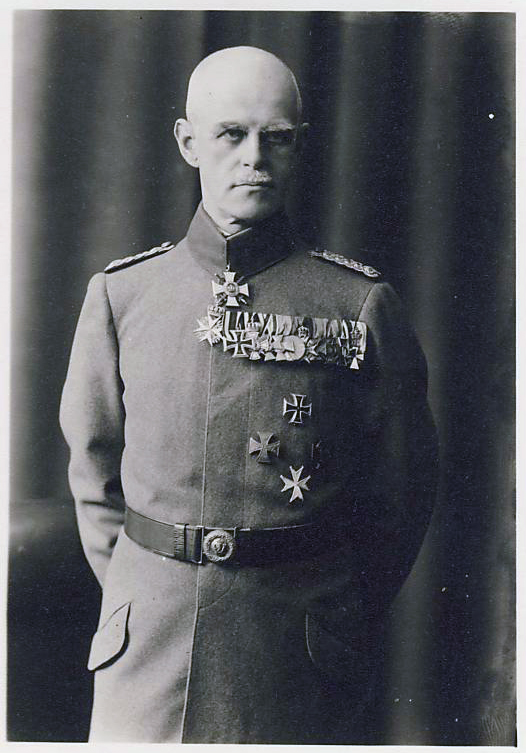 0
0 -
I think the Adolph of Nassau ribbon is more dark blue...
No. 6 could be the french order "Merite Sportif".
No. 7 could be the Monaco Order of Grimaldi (has to be an order with the "wings")
My best guesses...
/Michael
0 -
And regarding the Order of the White Elephant:
It was instituted in 1861 and exists in two types (different suspensions). Yours is the first type, but there seems to be some uncertainty as to when the second type was introduced.
/Michael
0




unknown swedish officer
in Northern European & Baltic States
Posted
That's the Swedish King Oscar II
/Michael